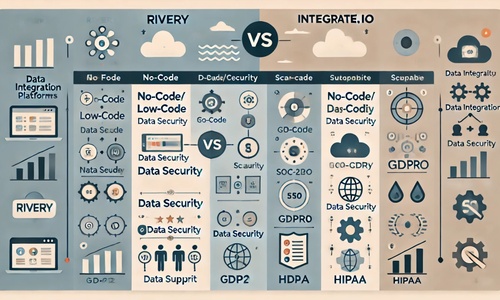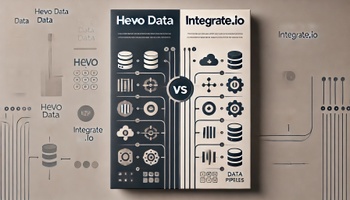In the rapidly evolving landscape of data integration, selecting the right ELT/ ETL (Extract, Transform, Load) tool is crucial for efficient data management and analytics. Automated data connectors can easily make your data available for downstream applications like building dashboards. This article provides an in-depth comparison between Rivery and Integrate.io, two prominent data replication platforms, to assist data analysts in making informed decisions for their data teams.
Key Takeways
- By the end of reading this article, you can decide Rivery or Integrate.io or the combination of both the tools are suitable for your requirement
Overview of Rivery and Integrate.io
Rivery is a cloud-based ETL platform that offers a fully managed solution for data integration. It emphasizes automation and real-time data processing, providing a code-free environment suitable for both technical and non-technical users.
Integrate.io is a low-code data integration platform designed to simplify the data sync and end-to-end management of data pipelines for various data engineering use cases. It offers a user-friendly interface with over 220 pre-built transformations, enabling users to build complex workflows without extensive coding knowledge.
Key Features Comparison
|
Feature |
Rivery |
Integrate.io |
|
User Interface |
Code-free, intuitive interface |
Low-code, drag-and-drop interface |
|
Data Transformation |
Supports complex transformations with built-in functions |
|
|
Connectors |
Provides a wide range of connectors, including databases and SaaS apps |
Supports 100+ data sources, including SaaS, on-premises, and CRM systems |
|
Security Compliance |
Compliant with industry standards; offers field-level encryption |
SOC 2, HIPAA, GDPR, and CCPA compliant; provides AES-256 encryption |
|
Support |
24/7 global support with onboarding services |
24/7 customer support with hands-on assistance |
|
Pricing |
Pay-per-use model with no platform or connector fees |
Tailored exactly to each client's needs and requirements with a usage-based component couple with features and functionality. Clients choose which level of platform usage they will require and then which features and functionality to create a custom plan to fit their use case. |
Hands-On Example: Building a Data Pipeline
Let's explore the data integration processes of building data pipelines using both platforms, that focus on extract data from a source, transform it, and load it into a destination such as a cloud data warehouse from various data sources.
Rivery Example
1. Setup: Log in to the Rivery platform and create a new "River" (data pipeline). Select the data source (e.g., Google Analytics) and configure the connection by providing the necessary credentials.
2. Data Extraction: Choose the specific data entities to extract, such as user metrics or session data.
3. Transformation: Apply transformations using Rivery's built-in functions. For example, to calculate the average session duration:
- Use the "Add Column" function to create a new column.
- Apply the formula: total_duration / session_count.
4. Loading: Select the destination (e.g., Amazon Redshift) and configure the connection. Map the transformed data to the target schema and execute the pipeline.
Integrate.io Example
1. Setup: Access the Integrate.io platform and create a new package. Define the source (e.g., Salesforce) by selecting it from the list of connectors and providing the required credentials.
2. Data Extraction: Specify the data objects to extract, such as leads or opportunities.
3. Transformation: Utilize Integrate.io's drag-and-drop interface to apply transformations. For instance, to filter leads based on a specific criterion:
- Add a "Filter" component to the workflow.
- Define the condition, such as Lead Source = 'Web'.
- 4. Loading: Choose the destination (e.g., Snowflake) and set up the connection. Map the fields accordingly and run the package to load the transformed data.
Security and Compliance
- Rivery offers field-level encryption and adheres to industry-standard security practices, ensuring data protection during transit and at rest.
- Integrate.io is SOC 2, HIPAA, GDPR, and CCPA compliant, providing robust security measures, including AES-256 encryption. It also offers data transformations to mask and encrypt sensitive information, aiding in compliance with various regulations.
When to Choose Rivery vs Integrate.io
Choose Rivery if:
-
You require real-time data processing with a pay-per-use pricing model.
-
You prefer a code-free environment with a wide range of connectors.
-
You need a platform that supports complex transformations with built-in functions.
Choose Integrate.io if:
-
You seek a low-code platform with an intuitive drag-and-drop interface for ease of use.
-
You need extensive pre-built transformations and connectors that support scalability.
-
You operate in a highly regulated industry requiring robust compliance features.
Conclusion
Choosing between the data integration tools, Rivery and Integrate.io depends on your data integration requirements, team expertise, and operational priorities. Rivery offers a code-free, real-time data integration solution that’s particularly advantageous for teams seeking flexible, pay-per-use pricing and strong real-time processing capabilities. Its focus on simplicity and real-time data handling is ideal for organizations that need to act quickly on up-to-date information, especially in operational analytics contexts.
On the other hand, Integrate.io stands out for its robust low-code functionality, custom connectors, extensive pre-built connectors and transformations, and emphasis on regulatory compliance. Its intuitive, drag-and-drop interface is a valuable asset for teams looking to reduce development time and enhance productivity without extensive coding. With comprehensive security and compliance features, Integrate.io is well-suited for industries where data privacy and security are top priorities.
Ultimately, the right choice will depend on your organization’s specific needs. For no-code free, flexible real-time integration, Rivery is a strong option; for a low-code, secure, and highly compliant ETL/ELT solution, Integrate.io is an excellent choice. To get started with automating your data, schedule a time to speak with one of our Solution Engineers here.
FAQs
Q1: Can both Rivery and Integrate.io handle real-time data processing?
- Rivery: Yes, Rivery supports real-time data processing, allowing for immediate data updates.
- Integrate.io: Integrate.io primarily focuses on batch processing but offers scheduling and automation features to handle data updates efficiently.
Q2: Do Rivery and Integrate.io support reverse ETL?
- Rivery: Yes, Rivery supports reverse ETL, enabling data activation back into operational systems.
- Integrate.io: Yes, Integrate.io offers reverse ETL capabilities, allowing data to be pushed back into CRM systems and other applications.
Q3: How do the pricing models of Rivery and Integrate.io differ?
- Rivery: Rivery operates on a pay-per-use model with no platform or connector fees, making it cost-effective for varying workloads.
- Integrate.io: Pricing is tailored exactly to each client's needs and requirements with a usage-based component couple with features and functionality. Clients choose which level of platform usage they will require and then which features and functionality to create a custom plan to fit their use case.
Q4: Which platform offers better support for non-technical users?
- Rivery: Rivery provides a code-free environment with an intuitive interface, suitable for non-technical users.
- Integrate.io: Integrate.io offers a low-code, drag-and-drop interface, making it accessible for users without extensive technical expertise.









